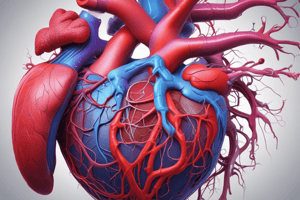Podcast
Questions and Answers
What is the primary function of the cardiovascular system?
What is the primary function of the cardiovascular system?
- Remove excess fluid from tissues
- Fight infections
- Transport oxygen and waste products (correct)
- Regulate blood pressure
Which chamber of the heart receives deoxygenated blood from the body?
Which chamber of the heart receives deoxygenated blood from the body?
- Right atrium (correct)
- Left atrium
- Left ventricle
- Right ventricle
Where is the apex of the heart located?
Where is the apex of the heart located?
- Behind the sternum at the 3rd intercostal space
- Along the left midclavicular line at the 5th intercostal space (correct)
- Along the right midclavicular line
- At the level of the 2nd intercostal space
What does stroke volume (SV) measure?
What does stroke volume (SV) measure?
What structure acts as the heart's pacemaker?
What structure acts as the heart's pacemaker?
What causes the 'lub' sound in the heartbeat?
What causes the 'lub' sound in the heartbeat?
Which component of the circulatory system is primarily responsible for fighting infections?
Which component of the circulatory system is primarily responsible for fighting infections?
How does sympathetic input affect heart rate?
How does sympathetic input affect heart rate?
Flashcards
What are the main components of the circulatory system?
What are the main components of the circulatory system?
The circulatory system includes the heart, blood vessels, and blood. It transports oxygen, carbon dioxide, nutrients, and waste products, regulates body temperature, and helps fight infection.
What is the lymphatic system's role?
What is the lymphatic system's role?
The lymphatic system is made up of lymph nodes, vessels, and lymph. It removes excess fluid from tissues, filters it, and returns it to the bloodstream. It also helps fight infection.
Where is the heart located in the chest?
Where is the heart located in the chest?
The base of the heart is located behind the sternum, near the 2nd intercostal space, and the apex is positioned along the left midclavicular line at the level of the 5th intercostal space.
What are the major tissues of the heart?
What are the major tissues of the heart?
Signup and view all the flashcards
What are the chambers of the heart?
What are the chambers of the heart?
Signup and view all the flashcards
How do the heart valves create the 'lub-dub' sound?
How do the heart valves create the 'lub-dub' sound?
Signup and view all the flashcards
Describe the path of blood flow through the heart.
Describe the path of blood flow through the heart.
Signup and view all the flashcards
How does the heart's conduction system work?
How does the heart's conduction system work?
Signup and view all the flashcards
Study Notes
Cardiovascular System
- Composed of the heart, blood vessels, and blood
- Transports oxygen, carbon dioxide, nutrients, and waste products
- Regulates body temperature and internal organ function
- Protects via the immune system, preventing infection and limiting blood loss through clotting
Lymphatic System
- Removes excess fluid from tissues, filters it, and returns it to the bloodstream
- Aids in fighting infections
Heart Location
- Base: behind the sternum at the height of the second intercostal space
- Apex: along the left midclavicular line at the height of the fifth intercostal space
Heart Tissues
- Endocardium: inner lining of the heart
- Myocardium: muscular layer
- Epicardium: outer lining of the heart
- Pericardium: fluid-filled sac surrounding the heart
Heart Chambers
- Right atrium (RA)
- Right ventricle (RV)
- Left atrium (LA)
- Left ventricle (LV)
Heart Valves
- Atrioventricular valves (lub sound):
- Tricuspid valve: between RA and RV
- Mitral (bicuspid) valve: between LA and LV
- Semilunar valves (dub sound):
- Pulmonic valve: between RV and pulmonary artery
Blood Flow Through the Heart
- Superior/inferior vena cava → RA → tricuspid valve → RV → pulmonic valve → pulmonary arteries → lungs → pulmonary veins → LA → mitral valve → LV → aortic valve → aorta → body
Conduction System of the Heart
- SA node (pacemaker) → AV node → Bundle of His → Bundle branches → Purkinje fibers
- Initiates and controls heart contractions without external nervous system input
Cardiac Function Terms
- Heart rate (HR): number of heart beats per minute
- Stroke volume (SV): volume of blood pumped with each beat
- Cardiac output (CO): blood pumped per unit time (HR x SV)
Autonomic Nervous System Influence
- Parasympathetic input decreases heart rate
- Sympathetic input increases heart rate
Electrocardiogram (ECG/EKG)
- Measures the heart's electrical activity using surface electrodes
- P wave: atrial depolarization
- QRS complex: ventricular depolarization
- ST segment: delay before ventricular repolarization
- T wave: ventricular repolarization
Studying That Suits You
Use AI to generate personalized quizzes and flashcards to suit your learning preferences.



